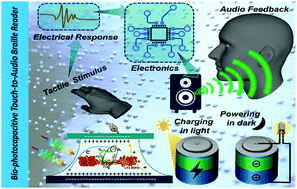Bio-photocapacitive tactile sensors as a touch-to-audio braille reader and solar capacitor†
Abstract
Human–machine interfaces in emerging smart-skin technologies tend to be focussed towards high-sensitivity tactile sensing primarily with visual/numerical feedback, and research on e-skin technologies for the visually impaired is sparse. Here we demonstrate a proof-of-concept six-pixel tactile sensor that converts touch stimuli based on braille codes into an auditory output, and which could potentially be miniaturized as an ‘energy-autonomous on-skin e-braille reader’ for the visually impaired. By applying the concepts of electric double layer capacitance and bio-photo capacitance, a self-powered sensor is constructed that generates electrical signals as large as 2 V by modulating a bio-electrochemical liquid bridge between electrodes of opposite wetting characteristics. The liquid bridge, composed of photosynthetic pigment–proteins with a redox electrolyte, both augments the sensory response and serves as a standalone solar-capacitor that can generate a photocurrent as high as 140 μA cm−2, and which displays a long discharge time of ∼20 min with just ∼3 min of photo charging.



 Please wait while we load your content...
Please wait while we load your content...